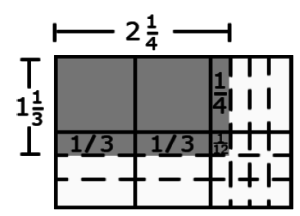Solve real world problems involving multiplication of fractions and mixed numbers, e.g., by using visual fraction models or equations to represent the problem.
[divider] [/divider]
Students are able to…
- Apply various strategies, such as make a model, draw a picture, look for a pattern, make a table, etc. to solve problems that provide a context for multiplying fractions with fractions, fractions with whole numbers, and fractions with mixed numbers.
- Explain how they solved problems using models, pictures, words, and numbers, in their explanation.
- Work within a group and individually using visual models and determine if their answer makes sense.
Students are able to…because teachers:
- Provide students with a variety of problems involving equal groups, arrays, and area, that offer opportunities for students to draw pictures or make models.
- Plan for opportunities during lessons for students to collaborate in small groups to solve problems with visual models and reason through their solution process.
[divider] [/divider]
Questions to ask students:
- In this problem situation, how did you know to multiply?
- Sample answer that indicates understanding: In the problem, I know the number of groups and the number in each group so I am looking for the product. This makes it a multiplication problem.
- Sample answer that indicates an incomplete understanding or a misconception: I am not sure if it is multiplication or division. I think I need to multiply.
- Why did you draw this type of model when solving this problem?
- Sample answer that indicates understanding: If I have 3 pieces of ribbon and each piece is 2 ½ inches long, I need to multiply to show 3 groups of 2 ½ inches. My number line model shows the 3 groups of 2 ½ inches.
- Sample answer that indicates an incomplete understanding or a misconception: I drew a rectangle that is 2 ½ inches long and I divided it into 3 parts.
- Jayden and Dariel are making a poster for a class assignment. The dimensions of the poster need to be 1 and 1/3 feet by 2 and 1/4 What will be the area of the whole poster?
- Sample answer that indicates understanding: A student draws the following to show the array made by multiplying the two factors. The student adds all of the partial products in the model for a total of 3 square feet.
[divider] [/divider]
FSA Notes
Cognitive Complexity Level: Level 2: Basic Application of Skills & Concepts
Achievement Level Descriptors: (Also assesses 5.NF.2.4)
Level 2: shows the product of a fraction by a whole number using visual fraction models; solves realworld problems involving multiplication of a fraction by a whole number by using visual fraction models or equations to represent the problem
Level 3: finds the product of two fractions by using an area model; generalizes that a/b x c/d = (ac)/(bd) and uses it to solve mathematical or realworld problems involving multiplication of fractions
Level 4: solves real-world problems involving multiplication of fractions and mixed numbers; creates a real-world context involving multiplication of fractions and/or mixed numbers
Level5: finds the possible fractional dimensions of a rectangle given the area; solves multistep mathematical and real-world problems involving multiplication of whole numbers, fractions, and/or mixed numbers
Assessment Limits: MAFS.5.NF.2.6 is assessed with MAFS.5.NF.2.4
- Visual models may include:
- Any appropriate fraction model (e.g., circles, tape diagrams, polygons, etc.)
- Rectangle models tiled with unit squares
- For tiling, the dimensions of the tile must be unit fractions with the same denominator as the given rectangular shape.
- Items may not use the terms “simplify” or “lowest terms.”
- Items may require students to interpret the context to determine operations.
- Fractions may be greater than 1.
- For given fractions in items, denominators are limited to 1‐20.
[divider] [/divider]
Additional Resources:
Additional in depth content knowledge:
Videos:
Multiply a fraction by a fraction using visual representations
Multipy a mixed number by a mixed number using visual representations
Sample Formative Assessment Tasks:
[divider] [/divider]
[divider] [/divider] Resources/Tasks to Support Your Child at Home:
- LearnZillion Video: Multiply Fractions by Fractions: Using a Sequence of Operations
